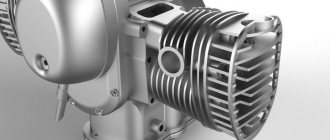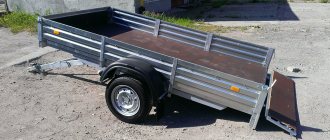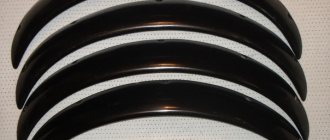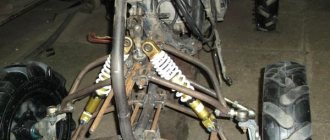Forward flow on a motorcycle
Quite often, unpleasant situations arise due to the bike’s lack of a loud exhaust system. Such an arsenal of “weapons” allows two-wheeled vehicles to always be noticed on the road. In addition to safety, direct flow to a motorcycle with your own hands also has a huge aesthetic role. For example, installing a brand new exhaust on a bike gives it extra beauty. In addition, it will certainly please the ears of the motorcycle driver.
You can independently correct the sound of a motorcycle without professional tuning workshops. If you have the right hands and a small amount to purchase materials, half the work has already been done.
How to make forward flow on a motorcycle? The answer to the question can be varied, since currently there are several technologies for manufacturing this exhaust system. The main difference between all these methods is the external and internal appearance of the muffler.
It is as simple as possible to create and install a standard motorcycle forward flow system, the photos of which are not even surprising. At the same time, the fastening bolts are unscrewed and the old version of the muffler, which was installed in factories, be it Chinese or Soviet manufacturers, is removed. The next step when installing a standard type of forward flow on a motorcycle with your own hands is to throw out all the insides of the old muffler system. You will have to say goodbye to several pipes and other offal once and for all. Then we use the machine to make a small straight tube without any irregularities on its surface. Thin-walled stainless steel can be used as the base material. The size of the latter should not exceed those of the original muffler.
Do-it-yourself forward flow on a motorcycle
The above standard type fabrication continues by densely packing glass wool throughout the area, which separates the muffler shell as well as the tube and steel that you created yourself. The only risk that arises during such an event is one that is directly related to fire resistance. To minimize it, the tube is wrapped with asbestos. It is the latter, such a common material, that is considered highly resistant to fire. It will minimize the risk of fire.
Well, then you can mount the muffler back to the bike, using the same bolt-on mount. Just remember to cover its outlet (outlet) part with a lid. If forward flow to a motorcycle, photos of which are quite common on the Internet today, is done with a reasonable approach, you will hear a bass tone in the sound. However, the operation of a standard forward flow will be poorly visible to your neighbors on the roadway.
Another way
Direct flow motorcycles are created in many variants. If you work hard, including engineering, you will probably invent a new type of forward flow for bikes yourself.
With TIG welding, as well as some highly practical tools (grinder and rollers), you can create a different type of direct-flow exhaust from the standard one. This time, the use of stainless steel as the base material involves fastening its individual elements by arc-argon welding. The latter makes it easy to roll stainless steel into a pipe.
Using a special sheet, create a partition by drilling holes in it. How to make forward flow on a motorcycle without having any special skills for this? - Yes, very simple. In practice, you can learn a lot with just desire.
The above type of exhaust system also requires several end caps. Having created them, we can consider that most of the work is done. Now all that remains is to insert the non-flammable material, placing it between the walls of the inner and outer pipes.
Direct flow on a motorcycle can be installed using elements of the car exhaust system. The only difficulties, in this case, can only be caused by differences in car and motorcycle mounts. Having welding at hand, this contradiction is very quickly eliminated. All resulting welds can be hidden under chrome paint. The velvety sound of a car exhaust will surely delight your ears.
Do-it-yourself straight-flow motorcycle will never harm your finances, which cannot be said about products purchased from professional workshops.
Nowadays, the creation of motorcycle forward flows is considered a very common element of the tuning process and attracts many craftsmen from different countries.
Why do people around you irritate your updated motorcycle?
First of all, the deafening volume that is inherent in most straight-through exhausts puts pressure on your eardrums and echoes throughout the surrounding area. This is really unpleasant, however, it is even worse when motorcyclists accelerate in place for the sake of self-affirmation (or who knows what else).
They break the silence and exceed permissible noise limits. Their roar causes car alarms to go off falsely, cell phone conversations become shorter due to the inability to hear the interlocutor, and a small child wakes up every now and then. They seem to accurately guess the time when you are going to sleep or relax on your day off.
If you yourself are a motorcyclist, then it’s worse for you =) You will certainly be identified with “noisy bikers” just because you ride a motorcycle (and it doesn’t matter which one). Get ready for stereotypical thinking.
Are there any advantages to direct flow?
Why are some motorcyclists desperate to turn up the volume on their steed? Their classic argument: “Loud exhaust saves lives.” This argument works in occasional situations that are typical on our roads, but there is no scientific evidence of the benefits of loud exhaust in avoiding accidents.
Moreover, this argument presupposes the correct behavior of road users when they hear a motorcycle roar. But this is an extremely risky assumption: the driver may be frightened by a loud roar next to him and behave completely differently from what is expected of him, which can be dangerous for the motorcyclist. A loud exhaust may be noticeable, but it is unlikely to be a more effective means of preventing accidents than safe driving skills coupled with reflective elements on equipment and a mandatory helmet on the head.
Even if the "loud exhaust saves lives" argument works in some situations, it doesn't do enough to compensate for the unpleasantness of it. To be honest, many motorcyclists use forward flow to attract attention and show off their own “coolness”, without caring about their safety or those around them.
This justification for using direct flow is too selfish, don’t you think? On one side of the scale is the joy of motorcyclists, on the other is the peace of those around them. Which of these is most important?
How to make forward flow on a motorcycle?
The answer to the question can be varied, since currently there are several technologies for manufacturing this exhaust system. The main difference between all these methods is the external and internal appearance of the muffler.
It is as simple as possible to create and install a standard motorcycle forward flow system, the photos of which are not even surprising. At the same time, the fastening bolts are unscrewed and the old version of the muffler, which was installed in factories, be it Chinese or Soviet manufacturers, is removed. The next step when installing a standard type of forward flow on a motorcycle with your own hands is to throw out all the insides of the old muffler system. You will have to say goodbye to several pipes and other offal once and for all. Then we use the machine to make a small straight tube without any irregularities on its surface. Thin-walled stainless steel can be used as the base material. The size of the latter should not exceed those of the original muffler.
Types of mufflers
A motorcycle muffler is a device that weakens the sound of the engine. Mufflers are needed not so much to reduce noise as to change the timbre. And high-frequency sounds have a more unpleasant effect on the human psyche and ear than low tones.
Many people associate the roar of sports motorcycles with a muffler. And they believe that filling the muffler can reduce the power of the car. But that's not true. When replacing or modifying a muffler, only a small amount of horsepower is lost.
There is an intake and exhaust silencer. And scientific research has proven that if you choose the right basic elements, you can improve the filling of the cylinder. Such mufflers are called resonant mufflers.
Noise suppression is carried out by the part of the muffler located behind the first partition, and it consists of an acoustic filter. These filters on sports motorcycles are made simpler, since a higher noise level is allowed in sports motorcycles.
When deciding to remake a muffler, you need to remember the following. Sometimes, when improving one part, you have to sacrifice the quality of another. No one has yet succeeded in creating a universal motorcycle.
Manufacturers recommend using factory mufflers for your motorcycle. The muffler cavity becomes covered with carbon deposits, which can close the acoustic filter channels. Therefore, the cavity of the device must be cleaned regularly. The resulting carbon deposits prevent the exhaust gases from escaping, and engine power is reduced. After every five to ten thousand kilometers, mufflers need to be cleaned.
The original mufflers are quite quiet and good. Their disadvantage can be considered their heavy weight and size. Many consider their high price to be a disadvantage. Silencers are produced by many companies, and you can use a non-original muffler if you wish. Most often these are open mufflers. In them, exhaust gases exit the engine without any obstacles. But they make a lot of noise.
Those who love the loud roar of motorcycles can buy the cheapest muffler, which does not muffle anything. But if the roar of the motorcycle does not suit you, then you will have to buy an expensive option.
These mufflers differ in design and material of manufacture. There are four types:
- Titanium. He is considered the best. It's light, looks nice, and doesn't get too hot.
- Aluminum. Light enough. It looks worse than titanium, but there is a drawback. You can get seriously burned.
- Carbon. Looks nice, light and cool. But its significant drawback is that even with vibrations it can crumble.
- Stainless steel. Strong and heavy, but very hot.
Each type of muffler has its own advantages and disadvantages. Therefore, you need to choose for yourself.
Do-it-yourself forward flow on a motorcycle
The above standard type fabrication continues by densely packing glass wool throughout the area, which separates the muffler shell as well as the tube and steel that you created yourself. The only risk that arises during such an event is one that is directly related to fire resistance. To minimize it, the tube is wrapped with asbestos. It is the latter, such a common material, that is considered highly resistant to fire. It will minimize the risk of fire.
Well, then you can mount the muffler back to the bike, using the same bolt-on mount. Just remember to cover its outlet (outlet) part with a lid.
If forward flow to a motorcycle, photos of which are quite common on the Internet today, is done with a reasonable approach, you will hear a bass tone in the sound.
However, the operation of a standard forward flow will be poorly visible to your neighbors on the roadway.
Another way
Direct flow motorcycles are created in many variants. If you work hard, including engineering, you will probably invent a new type of forward flow for bikes yourself.
With TIG welding, as well as some highly practical tools (grinder and rollers), you can create a different type of direct-flow exhaust from the standard one. This time, the use of stainless steel as the base material involves fastening its individual elements by arc-argon welding. The latter makes it easy to roll stainless steel into a pipe.
Using a special sheet, create a partition by drilling holes in it. How to make forward flow on a motorcycle without having any special skills for this? - Yes, very simple. In practice, you can learn a lot with just desire.
The above type of exhaust system also requires several end caps. Having created them, we can consider that most of the work is done. Now all that remains is to insert the non-flammable material, placing it between the walls of the inner and outer pipes.
Direct flow on a motorcycle can be installed using elements of the car exhaust system. The only difficulties, in this case, can only be caused by differences in car and motorcycle mounts. Having welding at hand, this contradiction is very quickly eliminated. All resulting welds can be hidden under chrome paint.
Nowadays, the creation of motorcycle forward flows is considered a very common element of the tuning process and attracts many craftsmen from different countries.
Making a direct-flow muffler from scratch
You can make such a muffler from scratch. This will be a completely new version made from several components. The difficulty of this operation, called tuning from scratch, lies in finding the diagram of the exhaust system of a particular moped.
Tools and materials
In this case, again, you need to prepare the necessary tools and materials.
Let's start assembling
First of all, you need to cut 18 cm from one of the pipes. It is recommended to carefully process the place in the cut with a needle file. From the second pipe we cut a circle with a diameter of 1.5 cm. We process it using the method described above. Glue the cut out circle in the section of the first pipe. We cut off another piece of pipe, 18 cm long. We make many holes in it. This can also be done with a sharp nail.
We connect all the parts using a welding machine. We fill the cavity formed at the junction of two pieces of pipe with mineral wool. We wrap the finished product with a special fire-resistant material. The homemade muffler is ready. To install it, you will need to attach the element to the scooter body mount.
Making a muffler mounting element
From plexiglass, which is indispensable in this matter due to its strength and easy paintability, we cut out a special type of ring, the edges of which can be bent outward by 180 degrees. We attach the resulting circles with serifs to the moped using the required bolts. We polish the muffler using sandpaper. To be sure, the joints between the homemade product and the moped body will need to be lubricated.
Homemade muffler for moped disassembled
If homemade production causes certain difficulties, you can find a lot of models of mufflers already in finished form. They are usually inexpensive. On the other hand, only a homemade version can provide the ideally expected option.
Source
Direct flow muffler
In the modern world there are a large number of bikers who value motorcycles for the roar that they make while riding. This is achieved thanks to direct flow. All motorcycles have different technical parameters that distinguish one model from another. Many motorcyclists make sure in advance that their “iron beasts” have a stronger roar and choose motorcycles with a powerful engine. However, in cases where the engine power is not enough for the roar to be of the required intensity, motorcyclists use their ingenuity and try to transform their bike.
Muffler replacement
The noise reduction device must be changed from time to time. In most cases, after a certain period of use, it begins to make loud and unpleasant sounds during operation. This is facilitated by the development of corrosion, burnout of perforated areas of pipes, and breakdown of sound reflectors.
First of all, you need to park the car on a flat, hard surface, make sure that the car does not roll anywhere, and jack it up. It is better to install it on trestles after lifting the car, but you can also use an inspection hole.
Before removing the muffler, it is recommended that you lubricate all bolts and clamps that will need to be removed with a penetrating lubricant such as WD-40. You can try removing the rust with a stiff steel brush. In the worst case, you will have to cut the bolts, as the flanges often become sour.
Next you need to remove the muffler itself. First, you need to unscrew the bolts on the flanges, after which you separate the muffler from the exhaust pipe, which is then recommended to be secured with a rope or some kind of wire to the steering rack so that it does not dangle.
The muffler is then removed from the rubber pads that cushion it.
After unscrewing all the bolts and removing all the cushions, the muffler should simply be pulled out.
The new muffler must match your car model and make. It is recommended to buy it from trusted auto stores and trusted brands. It is worth paying attention to the quality and thickness of the steel on the tank. On average, it varies from 1.2 to 1.5 mm.
Installing a new muffler is carried out in the reverse order described above. In general, there is nothing complicated.
You can watch the video :
Forward flow on a motorcycle
Not all people like the noise that direct-flow mufflers make while driving on the roads. They do not allow people in residential buildings to sleep peacefully; the noise of the mufflers has a frightening effect on children.
Some motorcyclists who oppose the use of mufflers on motorcycles argue that they prefer a quieter ride that does not cause inconvenience to others.
However, those who use forward flow on a motorcycle say that this part is necessary to ensure safety.
Direct flows help in the following situations:
- when it is necessary to signal your presence to drivers on the road
Everyone knows that not all car drivers like motorcyclists. They try to harass them and not pay attention to the fact that a biker is riding next to them. This leads to the fact that if you do not signal your presence to the car driver while driving on the road, he will not notice you. When the use of sound signals and other things is not enough, the input can enter a forward flow. It makes a roar, which makes it possible to move along the highway without unnecessary trouble.
- when you want to equip your motorcycle with an attractive attribute to change its external qualities.
Almost every motorcyclist has moments when he wants to change something. It can be installed for safety and as a decorative element of the arc on a motorcycle; when it is already there, you can try to make a forward flow. It will give you the opportunity to experience the new capabilities of any motorcycle device.
Direct flow muffler diagram
Independent work
Making a motorcycle muffler can be quite simple, but will it fully meet the requirements for it? Get ready for the fact that the first product you make with your own hands will require certain modifications and many hours of adjustments. However, practice shows that the second or third time it is possible to make a muffler for a motorcycle that initially meets all the required parameters. Sometimes it happens that it is not possible to make the required muffler for a motorcycle at all - this may be due to a lack of experience or certain design features of the equipment. In this case, it is better to buy a finished product from a well-known manufacturer or order the production of a direct flow from a real professional.
Source
DIY straight-through muffler
Today, a large number of additional accessories have been developed for motorcycles that serve various purposes. Direct flows are suitable for bikers who love to hear the sound of a roaring engine. They are produced by various companies. Thanks to this, everyone has the opportunity to choose the most optimal option for themselves. However, there are motorcyclists who have a limited budget, but for them, re-equipping and equipping a bike with everything necessary is not a difficult task. After all, they can do everything they need on their own.
It is best to make a do-it-yourself forward flow onto a motorcycle from a high-quality steel tube of the optimal size. It can have different shapes and lengths. The main thing for its fire resistance is to cover the surface with a protective layer.
For the tube, you need to assemble two end caps and make holes in them. All work is carried out using a welding machine.
Assembling a muffler with your own hands is not difficult. The main thing is to have welding skills in order to assemble all the parts together. If you do everything correctly and carefully, you can assemble a muffler similar in quality to those sold in motorcycle dealerships.
How to make the exhaust quieter with your own hands
Upgrading your machine will help make it as quiet as possible. Everyone knows that noise cannot be completely eliminated, but it can be reduced. To create a quiet muffler, different methods are used:
- install another muffler in place of the old one;
- I install an additional resonator;
- install a resonator equipped with an absorbing filler.
Each of the above methods has advantages and disadvantages. If you are upgrading your car's exhaust system yourself to reduce the exhaust sound, you need to have everything you need for the job. For such manipulations you need to have a set of car mechanic tools. You will also undoubtedly need:
- Welding machine. If a choice is possible, then use a semi-automatic or inverter;
- Angle grinder (angle grinder) with a set of discs;
- A workbench equipped with a vice.
Before starting work, you must choose one of the methods for upgrading the exhaust pipe. The first method is to install another factory-made resonator in the area between the first resonator and the muffler. You can also make it yourself.
The first option is the simplest, most popular and accessible. When choosing a method for constructing a low-noise muffler, it is necessary to take into account that the chosen method will lead to various financial expenses. If the owner of the car has the required amount of money, then it is best to purchase a resonator, remove a fragment of the pipe and weld the purchased device into the free space. The second method is undoubtedly much more interesting. The manufacturing technology of such a mechanism must be carefully studied before proceeding with its implementation.
How to make a forward flow on a motorcycle with your own hands
By increasing the power of their apparatus, motorcycle owners are faced with the problem of gas exhaust, and then the question arises of how to make a direct flow to the motorcycle. What is forward flow? Trying to push their engine to its limits, fans of fast driving are chasing even the smallest improvements in tank performance. Having achieved the maximum effect from all resources, the turn moves to the exhaust pipe.
Direct flow serves as a system of unidirectional movement of liquids or gases. In the factory version of the motorcycle, a standard exhaust pipe is enough, and after increasing the power, the exhaust of gases is difficult due to their increased amount of exhaust gases. Exhaust system professionals can add about 3-5 horsepower to a motorcycle . This is a very good indicator. In addition, they pay special attention to the sound produced by the muffler.
If your budget does not allow you to turn to specialists, there is an easy way to make a forward flow on a motorcycle with your own hands. This procedure is quite simple and not expensive. There is no need to purchase materials. You can find them in your garage.
How to make a quiet muffler on a car - tuning the silence
Only a small part of car enthusiasts would like to have a loud sports exhaust on their car. The vast majority of drivers, on the contrary, are puzzled by the question of how to make a quiet muffler. Driving can be comfortable only if as little extraneous sounds as possible enter the cabin. The muffler creates its own background noise, which can be significantly reduced. The effect of this cannot be ignored.
Basic ways to make a muffler quieter
Before you begin upgrading your exhaust system, you should understand the nature of the increased exhaust sound. With each working stroke of the piston, a micro-explosion occurs in the combustion chamber of the engine cylinder, which is accompanied by a significant sharp expansion of gases. Naturally, a kind of blast wave, after it has done its job and moved the piston down, rushes through the exhaust system with the opening of the exhaust valve.
Thus, the nature of exhaust system noise is twofold:
- sound from expansion of gases;
- noise from vibration of exhaust system elements.
As you know, the main way to combat noise is to increase the weight of the elements. The thicker the metal, the less vibration and, accordingly, noise. That is why the exhaust manifold, which is the first to absorb hot gases from the cylinder head, is made so massive. Many car enthusiasts who had the opportunity to compare the weight of the exhaust pipe of a domestic car and a foreign one noted that the exhaust system parts of foreign cars are much heavier. This is why “our” cars are less comfortable in sound and noise comparisons.
Special elements are designed to reduce the speed of gas movement in the exhaust pipe: resonators and mufflers. First in line is the resonator. As soon as gases under pressure enter a part of the pipe with an increased volume, they immediately lose some of their energy and move further with less momentum. In the muffler labyrinth system, the exhaust gases finally lose their energy and are dissipated. A real quiet muffler on a foreign car is quite heavy and has several separate housings.
Do-it-yourself quiet muffler, video:
Making a quiet muffler with your own hands
When starting to modernize the exhaust system in order to reduce exhaust sound, you should be prepared technically and financially. For work you will need a full set of car mechanic tools. In addition, you will definitely need:
- welding machine (preferably semi-automatic or inverter);
- angle grinder with a set of discs;
- a workbench equipped with a vice.
One of the most affordable ways to get a quiet muffler in the average garage is to include an additional resonator in the existing exhaust system.
There are also two options for upgrading the exhaust system: installing an additional factory-made resonator in the area between the main resonator and the muffler, or making the device yourself.
When considering how to make a muffler quieter, it should be borne in mind that any of the options may entail different costs. If the car enthusiast is not limited by budget, then you can safely buy a new resonator, cut out part of the pipe and weld it into the free space. The second method turns out to be more exciting and should be described in more detail.
The manufacturing technology of an additional resonator consists of the following stages:
- manufacturing a body (barrel) from a piece of thin-walled steel pipe or sheet steel in the form of two halves;
- making holes in a section of the exhaust system pipe corresponding to the length of the body behind the main resonator;
- connecting the body halves on a pipe with holes and scalding;
- laying basalt mineral wool into the cavity of the new body;
- welding of the end parts of the resonator.
Finally, the welds should be processed, the new resonator should be cleaned and degreased, and if possible, painted with heat-resistant paint.
Video, what is an exhaust manifold and resonator?
Additional problems of a quiet car
Once the question of how to make a quiet muffler has been resolved, some problem areas become apparent. First of all, it should be remembered that any of the methods for producing a “quiet” exhaust system will certainly lead to an increase in the weight of the structure.
This, in turn, obliges the car owner to take additional measures to strengthen the brackets and rubber shock absorbers. Another point to consider is the change in the balance of air entering the engine and exhaust gases. After upgrading the exhaust system, it is imperative to test the operation of the engine in different modes and make additional adjustments to the fuel supply and air filtration system.
Work process
Let's figure out how to make a forward flow on a motorcycle with your own hands? The workflow takes a little time. The main problem may arise if you use silencers from other companies. Their direct flows may not fit the fastenings, which is why you will have to tinker with the installation.
If you want to modify the system a little, you can throw away all the standard internals. Then you need to make or buy a pipe with thin walls. An excellent option would be a millimeter tube made of aluminum or steel. It must not contain defects. If there are dents, cracks, chips, then during the trip excess metallic noise will be created. The dimensions should not exceed standard ones, otherwise the exhaust of gases will be difficult. A homemade direct flow to a motorcycle should not violate the requirements for maintaining the bike.
There is a significant gap between the outer “can” and the new installed pipe. It must be filled to reduce noise. Materials like glass wool will work. During operation, it is important that the clogged material does not catch fire. To do this, the pipe is wrapped with asbestos. Its fire resistance will minimize the risk of fire. After filling with filler, the direct flow is installed on the motorcycle. After you finish the installation, start the motorcycle and listen to the new sound. It should have a slight bass response when working. However, even if you make a slight modification to your forward flow, few will be able to distinguish it. If you want to stand out, then there is another way to create a new exhaust pipe.
When creating a sonorous forward flow, it is necessary to understand the meaning of its work. In general terms, we can say that it is a system for controlling gases and liquids in a heat exchanger, in which the substances separated by the wall move in one direction. Thus, there are many different types of forward flow, aimed at both increasing power and changing the sound.
Does forward flow affect the power of a motorcycle?
Installing a direct-flow exhaust helps the engine get rid of exhaust gases faster. The absence of any crossbars, flutes, DB killers and other fillings does not prevent the spent exhaust from leaving the engine. At the same time, they cool worse (long live hot exhaust pipes!) and are worse cleaned (every time someone puts a direct flow on a motor, somewhere in the world an environmentalist cries).
But the power, on the contrary, decreases in proportion to the increase in volume! After all, a motorcycle moves due to the fact that the engine transfers its energy to the wheel. A certain amount of energy is also spent on the emission of exhaust gases. It turns out that the exhaust system does not add, but rather absorbs power! Energy consumption can be reduced precisely by creating obstacles to the release of exhaust gases.
But on the other hand, when the exit is difficult, it is more difficult for the engine to work correctly, it “suffocates”. Therefore, the design of exhaust systems, both conventional and direct-flow, is a serious engineering challenge, the goal of which is to strike a balance between maintaining power and a pleasant loud sound. Simply drilling holes in the plug or pulling out the filling will not bring any results. On the contrary, such craftsmen often experience a significant increase in gasoline consumption, and after intervention it is necessary to reconfigure the carburetor. Only “real”, branded direct flows like Akropovich can maintain the balance of volume and power. Most tuned motorcycles from Japan are equipped only with branded forward flow from Yashimura and Akropovik.
How to make the exhaust quieter with your own hands
Many car owners are interested in whether it is possible to make their too noisy car quieter on their own. A very small number of car enthusiasts are satisfied with the deafening sports exhausts of a running car. For all people, the degree of convenience is very important.
Driving by car can only be enjoyable if you hear as little extraneous and unpleasant sounds as possible inside the car. Also, when traveling by car, it is not safe for the driver to switch to untimely loud sounds - this can lead to an accident. In addition, too loud sounds emanating from the car can cause dissatisfaction with the people around you.
The muffler creates its own background noise, which can be greatly reduced. The result is always very good.
It must be said that here there is information only about a typical exhaust system and muffler. The direct-flow system is not considered. Always remember that both systems are very different from each other. It should also be noted that information is not provided here about the method by which the internal structure of the muffler is rebuilt, a lot of welding work is carried out, etc. This article presents the most popular, accessible and simple methods.
Table of contents:
Does forward flow make it noticeable on the road?
It is impossible to give a definite answer to this question. Several important factors influence whether motorists can hear you:
- Speed. If you’re racing 150 around the city on a sportbike and fly into an intersection, suddenly jumping out from behind the cars, no one will have time to hear you. Such racers often find themselves in the side door of a turning car before the sound reaches the driver and gives him time to react;
- If you are flying with your forward flow, overtaking the flow and playing “checkers”, in the hope that the motorists driving ahead will hear your roar and refuse to change lanes from lane to lane - slow down. Otherwise, you will catch up with the car before the sound of your exhaust reaches the driver, and he may want to maneuver, having no idea that a biker will be nearby at that moment. In most cases, the roar of the engine in the car will only be heard when the pilot of the two-wheeled rocket has already flown far ahead;
- Vehicle type. It’s one thing to drive in an old Zhiguli or even a cheap foreign car, in which you can hear everything that rumbles on the road. And it’s completely different – in a maximally soundproofed premium jeep. In such a machine, your forward flow will go unnoticed;
- Music. If the car's speakers are turned on at full power, the driver won't care about your exhaust.
Why do motorcyclists need forward flow on a motorcycle?
The exhaust system is designed to perform several tasks.
Exhaust gases are removed. The exhaust gases better fill the engine cylinders. And dampens the noise. The spent mixture leaves the cylinders at a very high speed and therefore creates a loud noise. It is the muffler that reduces the noise of exhaust gases due to the obstacles installed in it. A straight-through muffler simply does not have baffles that reduce noise. In this case, exhaust gases exit without obstruction, and engine power increases. Therefore, the noise on such motorcycles is like a roar.
A direct-flow muffler or direct-flow muffler on a motorcycle produces a peculiar engine roar and is not accepted by many people. It is believed that motorcycles with such a muffler disturb people and pollute the atmosphere.
Motorcyclists who promote quiet riding in the city do not accept straight-through mufflers. But experienced bikers are sure that forward flow is not only passive safety, but even active safety on the roads. How? The fact that you can indicate your location in the traffic.
Best passive safety
When will forward flow really be noticeable? Only if the motorcyclist does not violate or exceed the speed limit. A “pot-bellied” cruiser with a loud bass exhaust, slowly cruising in a row or approaching an intersection, will be noticeable to everyone. Also when overtaking, it is important not just to suddenly fly past unsuspecting motorists, but to slowly and sedately drive around them, identifying yourself in advance. And when you need to attract attention, it is better to use the horn rather than the gas. This way you will only irritate the people around you, including pedestrians.
But the best passive safety is still increased visual visibility. Bright clothes, a white or acid-colored helmet, reflective elements on equipment, high-beam headlights during the day - this is what works much better than any forward flow.











